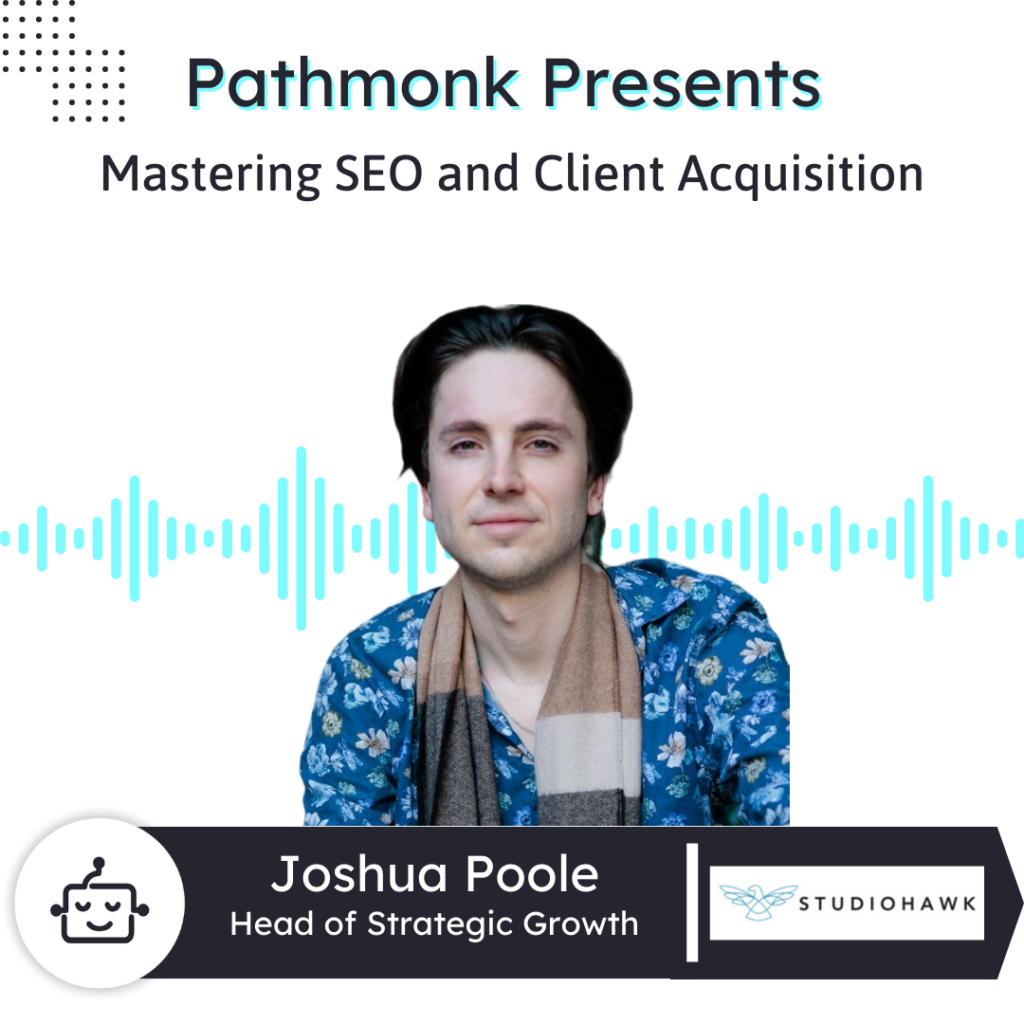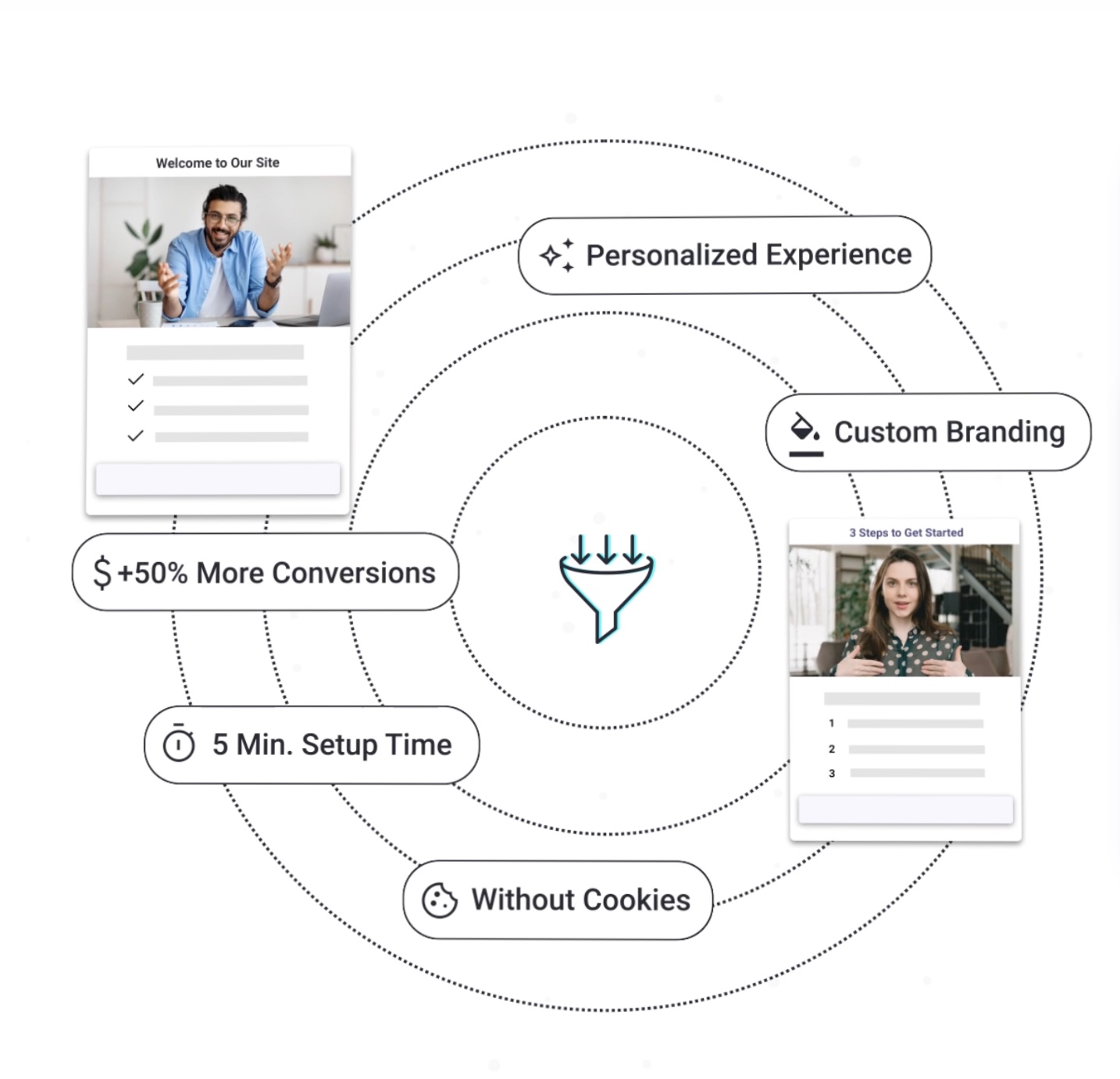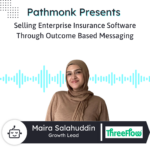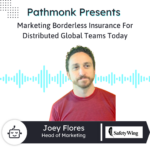
Introduction
Joshua shares valuable insights on SEO strategies, client acquisition, and effective marketing techniques. He discusses Studio Hawk’s unique approach to SEO, their ideal customer profiles, and the importance of a strong online presence. Joshua also offers practical tips on website lead generation, tool recommendations, and staying updated with marketing trends.
This episode is a must-listen for anyone looking to enhance their digital marketing strategies and drive business growth through SEO.
More Sales From Your Website With AI
Personalized interactions based on your users' behaviour to get +50% more conversions.

Ernesto Quezada: Pathmonk is the intelligent tool for website lead generation. With increasing online competition, over 98% of website visitors don’t convert. The ability to successfully show your value proposition and support visitors in their buying journey separates you from the competition online. Pathmonk qualifies and converts leads on your website by figuring out where they are in the buying journey and influencing them in key decision moments. With relevant micro experiences like case studies, intro videos, and much more, stay relevant to your visitors and increase conversions by 50%. Add Pathmonk to your website in seconds. Let the AI do all the work and get access to 50% more qualified leads while you keep doing marketing and sales as usual. Check us on pathmonk.com. Welcome to today’s show. Let’s talk about today’s guest. We have Joshua from Studio Hawk, winner of the Apex 2024 Rising Star of the Year award, hot for search awards. How are you doing today, Joshua?
Joshua Poole: Good, Ernesto, really well. How are you?
Ernesto: I’m doing great. Great. It’s an honor to have you on here with us, Joshua, and I’m sure our listeners are tuning in, wondering what today’s episode is going to be about. So, in your own words, can you tell us a little bit more about Studio Hawk?
Joshua: Yeah, sure. So Studio Hawk is an SEO agency based in Melbourne, Sydney, and London that specializes purely in SEO. We don’t do paid search, we don’t do social, we don’t do email, purely organic search. And really, the model of the business is based on three things. As I said, we’re channel experts specializing in the one channel, we don’t have locking contracts for any of our clients—it is a month-to-month service. And then the third thing is we don’t have account managers. A lot of agencies, especially traditional agencies, will have account managers who then work with the technicians to execute whatever needs to be executed. But what we did is remove the account managers and actually have our technicians directly embedded with the clients’ team themselves. So it feels like they actually have an SEO specialist or an SEO technician as part of their internal marketing team. That’s basically our model, and we service anyone from small businesses to some of the largest companies in the world in any industry.
Ernesto: All right, great. Awesome to hear that. And so that way our listeners who are tuned in, Joshua, can get a good understanding of Studio Hawk. What would you say is the key problem that you guys like to solve for clients?
Joshua: Really? Like, it’s actually so simple. Our key problem is that our clients want to get found on search engines. And what we do is support them in all various ways to get found on search. Because everyone searches—from the young teenager that’s got a phone and is Googling whatever, like how to make banana bread, to the CEO of Coca-Cola. Everyone is constantly searching online, and even for myself, I was chatting with someone the other day, and I was like, sure, I work in SEO, so I’m making searches all the time. But outside of my job, I’m probably searching on Google up to 50, maybe 100 times a day, maybe more. And sometimes even if I’m looking for a restaurant to go to at night, I might make 10-15 searches to find that restaurant just in that one sitting. So it’s just the importance that is put on search in the world. It is so massive. So really that’s the problem—supporting our clients to get found in search.
Ernesto: Important. All right, thank you so much for sharing that with us. So, these clients then—is there a certain vertical segment? Is there an ideal ICP that Studio Hawk likes to go for?
Joshua: Really, we have two main ICPs. We’ve got business owners and then individuals that work in the marketing department for a company. So we segment those into two. The business owner is usually someone that’s running a business from, say, half a million dollars in revenue to around three to four million dollars in revenue per year. So they don’t generally have a full marketing team at that point—they’re still doing a lot themselves, and we’ll work sometimes directly with that business owner to help them grow their business or support them in driving traffic to their site. The other ideal customer profile is the marketing manager, digital marketing manager, growth manager, or e-commerce manager role, where generally they’re working in a business from, say, five million dollars up to 100, 200, or 500 million dollars in yearly revenue, and more. We’ll be working with them directly because once a business gets to around five million dollars in revenue, generally they have some kind of marketing function going on that is not run by the business owner. And it ends up being quite different—presenting our offering to a business owner is very different from presenting it to a marketing manager because one of the main reasons is a business owner is generally quite invested in the business they founded, that they started as their baby, whereas when you’re presenting your offering to a marketing manager, it’s generally not their business. They’re getting paid to work there, but they’re not so emotionally invested. So it’s quite a different workflow and style of connecting to those two different ideal customer profiles. But as I said, we work in any industry, from blockchain to e-commerce to finance to health to really anyone.
Ernesto: All right. And say I was in e-commerce or finance, how would I usually find out about Studio Hawk? Is there a top client acquisition channel for you guys, Joshua?
Joshua: Yeah, our holistic marketing strategy covers many areas. What we’ve been discussing a lot lately is how people, like, what is their first touchpoint with Studio Hawk? And it’s quite hard to always work out what exactly that first touchpoint is. But some of the main ways that people initially discover us—say, in e-commerce, like, let’s say a marketing manager working for an e-commerce brand doing $20 million in revenue—some of the first main touchpoints are through SEO. We rank quite well in search. Obviously, we’re an SEO agency, so we’ve invested resources to get our site ranking. And we rank very well in, say, Australia for e-commerce SEO agency and e-commerce-related keywords. So we’ve had some e-commerce managers find us through those kinds of searches. Another way is through events and trade shows. We do a lot of talks and sponsor a lot of events, especially major conferences where there are a lot of e-commerce managers, marketing managers, and retailers that attend these conferences. That’s where they may see us for the first time and see one of our talks on SEO and meet us at our stand. Another way too is our PR strategy. We do a lot of creative storytelling, getting featured on large publications, getting featured on marketing publications to get our brand out there and get us in front of some of those high-ticket retailers and e-commerce merchants. That’s been a great way for us too, to get that first touchpoint, say, in a marketing publication that is read by our ICP. And some of them do actually reach out and begin a conversation.
Ernesto: All right, thank you so much for sharing that. And so that way our listeners who are tuned in could go ahead and visit you. They could always check you out at studiohawk.com.au. What role does the website play in client acquisition?
Joshua: Our website and our clients’ websites are vital because the way I see it, the website is really the home base of your whole digital strategy. If you’re spending on paid ads, if you’re getting featured in PR publications, if you’re doing events and trade shows, if you’re running SEO for your site—at the end of the day, users are always going to be funneled to your website, no matter what you’re doing. Even if you’re running a billboard ad or an ad on a bus stop, users are still getting funneled to the exact same place, which is your website. So really it all starts with website branding, messaging, and what you’re really trying to put out there. We’re really big on investing a lot in our website, from a messaging perspective, a design perspective, and also from a conversion perspective. But for us, it’s still big on branding and messaging. Conversion is still important, don’t get me wrong, but we really want to be communicating to the right audience. We don’t want our website to be too salesy—we still want it to have a really personalized approach. And then also, the design is really important to us too. Our mascot that we use is a hawk, obviously called Studio Hawk, so the hawk is part of our branding, etc. So really, the website is the home base. If you’re investing in SEO, if you’re investing in PPC, social, whatever it is, the user is still coming to your website. So really the website always comes first, and then all your strategies build off that.
Ernesto: Definitely. All right, awesome. Thank you so much for that. On that note, I really do want to ask, is there any tools, tips, or methods that you would recommend to our listeners as far as some website lead generation?
Joshua: Yeah, so if a business wants to look at growing their website, say, through search to drive more traffic and drive more leads to their website, a great tool to start with is Semrush. Semrush.com is probably one of the top two or three best SEO tools out there. I recommend all business owners and marketing managers have that tool. It’s a great way to see behind the scenes on how your site’s performing and how to actually improve the performance on the site through search. Another great tool is Google Analytics, GA4. We’re on GA4 right now, but GA4 is still really important. That way, you can see how users are actually engaging with the site. And also, if you set up events and conversion tracking, you can see where users are actually converting and what pages have the highest conversion rates. What a lot of people probably don’t realize is that, say, if they’re getting 10,000 users to their site, they actually may have a particular three, four, or five pages that have a really high conversion rate. So it’s really important to look at those pages to understand why they’re converting so high. And also, going back to what I said about the SEO tool, once you’re using Semrush, you’re able to see what are your top, say, five pages bringing the most traffic to the site, and also what pages actually have low-hanging fruit. Say, if you’ve got pages that are ranking in position four on search, they’re great pages to actually optimize so you can increase rankings and bring more traffic to the site. So really, you’ve got Semrush as a great tool, and then you’ve got GA4 and Google Tag Manager to set up your conversion tracking. Having those two tools really helps in understanding what users are doing on your site, and Semrush helps in understanding how to bring more users to your site.
Ernesto: All right, awesome. Thank you so much for those tips and tricks, Joshua. Let’s switch gears a little bit and talk about you as a leader, Joshua. What are some key tasks you like to focus on in your day-to-day work at Studio Hawk?
Joshua: Key tasks for me? My role at Studio Hawk is Head of Growth, so I handle three areas of the business: sales, marketing, and partnerships. It is over a $10 million yearly revenue business. We’ve got the sales front, which includes our sales process, pipeline activity, our proposal pitch process, our service offering, pricing, etc. Then we’ve got marketing, which is about how we generate more inbound leads and what initiatives we should take to generate more inbound leads. And then I’ve got the third area, which is partnerships, and generally, that’s agency partnerships because we’re a specialized SEO agency. We work with a lot of agencies around Australia and globally because we only offer one service, so a lot of our clients are looking for paid search, email, etc. We refer a lot of work out and lean on other agencies to ensure that our clients get the best results. The tasks that, if I break down percentage-wise of my role, it’s probably around 60% sales, 20-30% marketing, and 10% partnerships. Some of the main day-to-day focuses for me are managing the sales team, making sure our sales process is really tight-knit, overseeing our HubSpot flow, reviewing our dashboards, pipeline, and sales activity, and then scoping out and connecting with potential prospects, scoping out projects, and presenting tailored offerings to some of our largest clients, some of our largest businesses in Australia. Some of those businesses I’ll be speaking to are doing upwards of $100 million a year to $500 million a year to over a billion dollars in yearly revenue. So I really lead that charge on that end-to-end sales and onboarding experience for that type of lead to a Studio Hawk client prospect. That includes multiple discoveries, workshopping different strategies, creating a tailored strategy and roadmap that suits them and their needs, and then presenting different pricing options and what that 6-12 month roadmap looks like. And then if it’s all go-ahead and everything makes sense, then it’s really about onboarding into the SEO team so that we can deliver exactly what we’ve set out to the client. Those are some of my main day-to-day tasks, and then there are different marketing initiatives I do around our website, events, and trade shows, our creative strategy, branding, etc., etc.
Ernesto: Right. Interesting. I mean, it sounds like you have a full plate there on your hands. So, in the between times, Joshua, how do you stay up to date with all the news and marketing trends out there? Is there a preferred channel that you like to go with?
Joshua: Yeah, I love LinkedIn—pretty big on LinkedIn. There’s some really awesome content there. Don’t get me wrong, there is a lot of rubbish content online and a lot of information that is just useless, but on LinkedIn, there are some really great content creators pushing out some really high-value SEO content, digital marketing content that I really keep in sync with. Nothing beats reading a bit online, searching a few things on Google, reading some good articles, and understanding what’s going on. Another area where I keep up to date is just speaking to people in the community and understanding what they’re doing and what they’re working on. It’s really important for me. There are people working on some really cool stuff, and there are some really passionate people in the digital space who are just going above and beyond, really pushing the boundaries of what can be achieved and what kind of results can be achieved for clients. So I really like to stay on the pulse with certain friends and colleagues in the industry and understand what they’re doing.
Ernesto: Awesome, great to hear that. Thanks so much for sharing those methods in order to get a little bit more traction in the news and strategy. Well, let’s jump into our next section here, which is our rapid-fire question round. Are you ready for that, Joshua?
Joshua: Yeah, hit me.
Ernesto: All right, first off then, Joshua, what is the last book that you read?
Joshua: The last book I read… well, there was actually a book that I recommended to a friend the other day, and some people would know this book. It’s called The Alchemist. It’s been around for, I think, 10-20 years. It’s by a Brazilian author. The reason I recommended that book is I was discussing with a friend, you know, what is the meaning of life, etc., etc. And really, one of the messages in this book is about this boy who travels from Spain, across Europe, and into the Middle East, etc., and he’s looking for this golden chest. He sets out on this journey to find this chest of gold. And then when he finally gets to the point where this chest of gold is meant to exist, it doesn’t actually—it’s not even there. So he’s upset and sad, and he travels all the way back to where his hometown was and where he was initially living. And the chest of gold was actually—he ends up finding the chest of gold underneath the floorboards of where he lived. And I really love that metaphor and that symbolism. Life isn’t about searching outside yourself to find meaning or truth or purpose. It’s actually within, and it’s always there, whether it’s under your floorboards, under your nose, or wherever—it’s always internal. It’s always right there. It’s never about searching outside yourself. So, yeah, that’s the book I was talking to a friend about the other day.
Ernesto: I love that book. I’ve read it a couple of times. It’s a great book. Joshua, if there were no boundaries in technology, what would be the one thing that you want to have fixed for your role as a marketer today?
Joshua: If there were no boundaries in technology? I know it’s a bit cliche, but if I could see attribution as clear as day on a 100% level—what I mean by that is totally understanding where each of our clients and prospects, what is their entire journey and touchpoint journey to then come on board at Studio Hawk. Some of our prospects that do come on board—I brought on a client recently, and he first heard about us three years ago at a trade show, and then he saw us again at another event that we sponsored, and then he read an article that was published in a PR publication. Then he ended up coming through SEO, and I ended up having a conversation with him. It took around three months, and he ended up coming on board. That was a massive journey for that. I didn’t know that until I actually asked the client how he found us, and he ended up sharing with me that whole journey. I’m not as clear as I’ve shared it, but he shared a couple of things, and I pieced some stuff together. For me, it would be really understanding that, having such transparent attribution where I can understand the entire journey that a lead takes to then get to the point of me being able to have a conversation with them.
Ernesto: I think that’s super important. That’s really interesting. That’s an interesting buying journey that you mentioned, right? I mean, that took a while to get there, but it’s interesting, right? Something stuck. And that’s the beauty of marketing, right? Whenever somebody has something in there, it always stays, so they’ll go back to it at one point. Awesome to hear that. Next, Joshua, if there’s one repetitive task that you could automate, what would that be?
Joshua: For me in the sales process, follow-ups. I know that you can automate follow-ups, but the thing about follow-ups is that if I had a magic wand, I would love an automated follow-up process where every follow-up is personalized. It’s so hard to automate that, but having the most insanely personalized, cool follow-up approach that is constantly targeting and so tailored and personalized to each prospect that we speak with—whether it’s, say, an e-commerce client, with automated follow-ups that are already preset and so tailored, where they’re already getting our case studies, our YouTube videos, and it’s so tailored to the client. It’s so hard to have such a personalized, automated approach. You can only automate so far. That would be cool if I had the magic wand and every single follow-up was completely automated and tailored to that individual lead every time.
Ernesto: That would be really nice. I think somebody’s got to be trying. I mean, there are a lot of companies out there trying, right? But hopefully, somebody will perfect it at some point.
Joshua: Yeah, awesome.
Ernesto: Lastly, Joshua, you have a lot of experience already in the marketing world, but what is one piece of advice that you would give yourself if you were to restart your journey as a marketer today?
Joshua: I’ll talk about two things. I’ll talk about something on the marketing side and something on the sales side. For me, on the marketing side, it’s not about doing a million things at once or trying to come up with a million ideas. It’s not about that in marketing. It’s about working out solid approaches that suit our agency or whoever that have a material impact. Some of those solid approaches may only be for a year, and there might only be five things, but those five things actually have a material impact on the business. You can do so much research online, you can read so much content, you can see all these cool ideas that so many people are doing, and it’s really cool. But if things aren’t actually being executed and if those things aren’t being reviewed to understand how much of a material impact they’re having on business growth, then there’s no point in having all those great ideas. That’s something that, for me, I’ve learned a lot in recent times. It’s actually about consistency with the right ideas. It might only be three, but those three actually have a significant material impact. As long as we’re consistent with those things and expanding on them and improving on them, it’s getting better and better and actually supporting the business to grow. For me as a marketer, I’m really big on execution. I used to be really big on ideas, but then I realized it’s actually easy to have ideas. Don’t get me wrong, I’m not perfect, but there are so many ideas out there, and you can take so much inspiration from so many people—there’s an endless amount of ideas. But what’s really the most important part to me is the execution and what material impact that’s actually having on the business. If it’s not having a material impact, then it needs to be scrapped as soon as possible. On the sales front, sales is not about selling; it’s about building relationships. If someone’s reaching out and having a conversation with me, then they already want our service. I don’t have to sell them on our service—they already want it. So what I find now more than ever is it’s about sitting back and really not speaking that much to a prospect. It’s about listening to the prospect. I heard a quote a long time ago, and it was about the one controlling the conversation is the one asking the questions. I really like that; it really stuck with me during my sales process. It’s not about controlling the conversation; it’s just about allowing the client or the prospect to really speak, to feel understood and heard. To be honest, during a lot of my sales process these days, I actually ask so many more questions than I speak. Sometimes in my discovery calls or in my sales process, the client might speak 70-80% of the time. I’m only speaking 10-20% of the time. For me, sometimes what I find is the less I speak, the higher my chance of conversion, which goes against so much of what we think things should be. I’ve got to say all the right things, I’ve got to do all the right things. But people already want to buy, but they want to buy from people they like, and people generally like people when that person feels understood, heard, and met. So that is a big focus in my sales process. Those are the two things that I’ve learned since doing what I do.
Ernesto: Awesome. Thank you so much for sharing that, Joshua. Well, we’re coming to the end of our show here, but I do want to appreciate you being on with us today. I also want to thank our listeners for tuning in, and I’m looking forward to our next episode of Pathmonk Presents. Thanks a lot, Joshua.
Joshua: Thanks. Thanks for having me. Really appreciate it.











